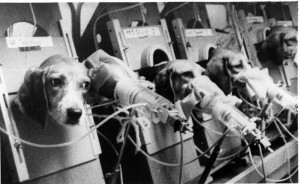Animal testing is an “archaic” technique that has been used millions of times to improve science, but is it just? With trial an error, more innocent animals have died than there have been successes, but what if those tests were done on humans… they would have all died too. Scientist as well as the general population typically have a very black or white perspective towards animal testing, but is it that simple?
Through vast examples in class, we have seen how the use of rats and dogs have furthered science. Oscar Auerbach trained beagles to smoke starting in 1967. While he induced the beagles with lung cancer, he was the first scientist to prove that smoking cigarettes has a direct causation to getting lung cancer. Source Watch The basic elimination of polio in the United States and Europe is due to Dr. John Enders and colleagues injecting monkeys, mice, and rats with polio, and later by Albert Sabin. In the Journal of the American Medical Association, Sabin stated “approximately 9,000 monkeys, 150 chimpanzees and 133 human volunteers have been used thus far in the quantitative studies of various characteristics of different strains of polio virus. These studies were necessary to solve many problems before an oral polio vaccine could become a reality.” (Animal Research). Though thousands of animals were used, billions of lives were saved.
On the contrary, many people feel as if too many animal lives are being waisted in these experiments, and the treatment of the animals is too cruel to allow for it to continue. “According to Humane Society International, animals used in experiments are commonly subjected to force feeding, forced inhala tion, food and water deprivation, prolonged periods of physical restraint, the infliction of burns and other wounds to study the healing process, the infliction of pain to study its effects and remedies, and ‘killing by carbon dioxide asphyxiation, neck-breaking, decapitation, or other means.’” One example of this obscene torture is the Drazie eye test This test is used to see if chemicals will irritate eyes. Rabbits eyelids are held open for long periods of time, and the chemical are put into the animals eyes. The rabbits are then killed after the experiment is concluded. Peta. Many opponents of animal testing argue that we are technologically and scientifically advanced enough to use other methods for experimentation.
tion, food and water deprivation, prolonged periods of physical restraint, the infliction of burns and other wounds to study the healing process, the infliction of pain to study its effects and remedies, and ‘killing by carbon dioxide asphyxiation, neck-breaking, decapitation, or other means.’” One example of this obscene torture is the Drazie eye test This test is used to see if chemicals will irritate eyes. Rabbits eyelids are held open for long periods of time, and the chemical are put into the animals eyes. The rabbits are then killed after the experiment is concluded. Peta. Many opponents of animal testing argue that we are technologically and scientifically advanced enough to use other methods for experimentation.
I understand both sides of the argument. While I am without a doubt not in support of animal cruelty, it has been proven in the past that animals have tremendously improved science. I think this is such a prevalent issue in science because animal testing is a ginormous part of the successes and failures within the field. I thought after researching both sides of the argument, I would have a clear understanding of where I stand. Hahaha boy was I wrong.
Though I am not a scientist, I am trying to understand this argument from there point of view. I think scientist don’t view this as a mortality argument but rather a realistic mechanism to improving the future. That is why this has been a lingering feud and it has been hard to compromise the use of animal testing. Though there is not a definite answer whether animal testing should continue to be used in the science world, that is why it fits in so perfectly to the science world. Science stimulates criticism, opinion, and judgement.

As an animal person who rides horses and owns pets, it is hard to think about animal testing. However, I believe I have never tried to fight it because I subconsciously know in the end that too many people will argue we need it for the future of science and medicine. I think that if we have come this far there should be a way to use science to replace animal testing with another testing method. I find it interesting that with some animals, such as mice, animal testing does not bother me as much. Maybe it is because I do not consider them as developed as dogs. It is hard to say what the right decision is in such controversial matter.